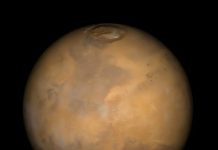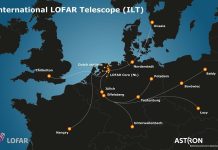
Astronomers using NASA’s James Webb Space Telescope have made an exciting discovery: frozen water, also known as crystalline water ice, in a young star system located 155 light-years away.
The star, called HD 181327, is much younger than our sun—just 23 million years old compared to the sun’s 4.6 billion years.
This finding is particularly important because it provides clear evidence that water ice exists outside our solar system, something scientists have suspected for decades but couldn’t confirm until now.
The discovery was made possible by Webb’s powerful instruments, which can detect fine details in space that previous telescopes could not.
NASA’s retired Spitzer Space Telescope hinted at the possibility of frozen water in the HD 181327 system back in 2008, but Webb’s advanced technology finally confirmed it.
The water ice was found in a dusty debris disk that orbits the star, much like the Kuiper Belt in our own solar system, where icy bodies and dwarf planets are located.
Chen Xie, the lead author of the study and a research scientist at Johns Hopkins University, explained that Webb’s instruments didn’t just detect any water ice—they found crystalline water ice, the same kind found on Saturn’s rings and in the Kuiper Belt.
This form of ice is purer and more structured than regular ice, making it easier to identify through the telescope’s sensors.
The water ice was discovered clinging to tiny dust particles scattered throughout the debris disk. These ice-coated dust grains are like “dirty snowballs” floating around the star. Interestingly, the ice is not spread out evenly.
Most of it is found in the farthest, coldest regions of the debris disk, where temperatures are low enough for water to freeze. In fact, over 20% of the material in the outer part of the disk is made up of water ice.
Closer to the star, where temperatures are higher, less water ice is present. In the warmest regions, almost no ice remains because the star’s ultraviolet light likely vaporizes it, or it may be locked inside rocks known as planetesimals, making it undetectable by Webb.
Christine Chen, a co-author of the study from the Space Telescope Science Institute, described the system as “very active,” with frequent collisions among icy bodies.
These collisions release small particles of water ice, which Webb’s powerful sensors can easily detect. The researchers used Webb’s Near-Infrared Spectrograph (NIRSpec) to observe the star and its debris disk. This instrument is incredibly sensitive and can pick up even the faintest traces of dust and ice that are invisible to other telescopes.
The discovery of water ice in this young star system is more than just a curiosity—it provides valuable clues about how planets form.
Water ice is a crucial building block for planet formation, and its presence in the HD 181327 system suggests that icy materials might eventually be delivered to planets that form there in the future. This is similar to how comets and asteroids are believed to have brought water to Earth billions of years ago.
For astronomers, this is just the beginning. The team plans to continue using the Webb Telescope to search for water ice in other young star systems throughout the galaxy.
Each new discovery brings scientists one step closer to understanding how planets—and possibly life—might form around distant stars.
Source: NASA.



